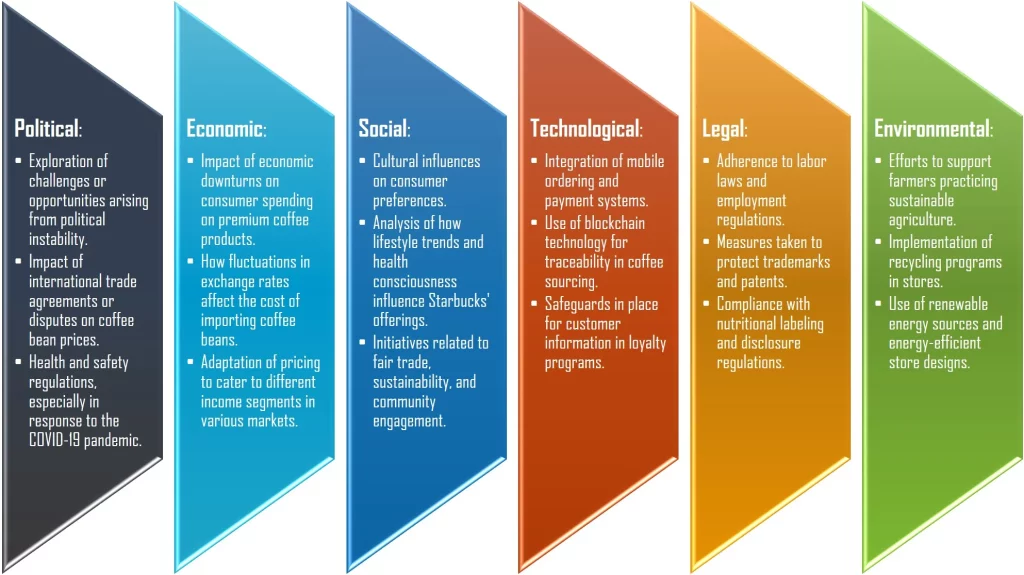
Below is a sample PESTLE analysis essay on Starbucks Corporation. This example is intended to help students write better business PESTLE analysis essays.
Starbucks PESTLE Analysis Essay
PESTLE Analysis Essay Outline: Starbucks Corp.
Here is the outline for this sample PESTLE analysis essay:
- Introduction
- Brief introduction to Starbucks Corporation.
- Significance of conducting a PESTLE analysis for strategic evaluation.
- Purpose of the essay: to analyze the external macro-environmental factors impacting Starbucks.
- Political Factors
- Global Expansion and Political Stability
- Discussion on Starbucks’ global presence and how political stability impacts its international operations.
- Example: Exploration of challenges or opportunities arising from political instability in certain regions.
- Trade and Tariffs
- Examination of how trade policies and tariffs influence Starbucks’ supply chain and pricing.
- Example: Impact of international trade agreements or disputes on coffee bean prices.
- Regulatory Environment
- Analysis of Starbucks’ compliance with various regulations in the countries it operates.
- Example: Discussion on health and safety regulations, especially in response to the COVID-19 pandemic.
- Economic Factors
- Economic Conditions and Consumer Spending
- Examination of how economic conditions influence Starbucks’ sales and profitability.
- Example: Impact of economic downturns on consumer spending on premium coffee products.
- Exchange Rates
- Discussion on the influence of currency exchange rates on Starbucks’ costs and pricing.
- Example: How fluctuations in exchange rates affect the cost of importing coffee beans.
- Income Levels and Pricing Strategies
- Analysis of how income levels of customers impact Starbucks’ pricing strategies.
- Example: Adaptation of pricing to cater to different income segments in various markets.
- Social Factors
- Cultural Influences on Consumer Preferences
- Exploration of how cultural differences impact consumer preferences for Starbucks products.
- Example: Tailoring menu items to suit local tastes and preferences.
- Lifestyle Trends and Health Consciousness
- Analysis of how lifestyle trends and health consciousness influence Starbucks’ offerings.
- Example: Introduction of healthier beverage options in response to changing consumer preferences.
- Social Responsibility
- Discussion on Starbucks’ commitment to social responsibility and ethical sourcing.
- Example: Initiatives related to fair trade, sustainability, and community engagement.
- Technological Factors
- Digital Innovation
- Examination of how technological advancements impact Starbucks’ operations and customer experience.
- Example: Integration of mobile ordering and payment systems.
- Supply Chain Technology
- Analysis of technological advancements in the coffee supply chain and their impact.
- Example: Use of blockchain technology for traceability in coffee sourcing.
- Data Security and Privacy
- Discussion on how Starbucks addresses data security and privacy concerns.
- Example: Safeguards in place for customer information in loyalty programs.
- Legal Factors
- Regulatory Compliance
- Examination of Starbucks’ compliance with legal requirements in various jurisdictions.
- Example: Adherence to labor laws and employment regulations.
- Intellectual Property Protection
- Analysis of legal considerations related to Starbucks’ brand and product innovations.
- Example: Measures taken to protect trademarks and patents.
- Product Labeling and Health Regulations
- Discussion on how legal requirements for product labeling and health impact Starbucks.
- Example: Compliance with nutritional labeling and disclosure regulations.
- Environmental Factors
- Sustainable Sourcing Practices
- Exploration of Starbucks’ commitment to environmentally sustainable sourcing of coffee beans.
- Example: Efforts to support farmers practicing sustainable agriculture.
- Waste Reduction and Recycling
- Analysis of Starbucks’ initiatives to reduce waste and promote recycling.
- Example: Implementation of recycling programs in stores.
- Carbon Footprint
- Discussion on Starbucks’ efforts to reduce its carbon footprint in operations.
- Example: Use of renewable energy sources and energy-efficient store designs.
- Conclusion
- Summarization of key findings from the PESTLE analysis.
- Implications of external factors for Starbucks’ strategic decision-making.
- Overall assessment of Starbucks’ adaptability to macro-environmental changes and its strategies for sustainable growth.

